Slick as a shave, only a lot funnier, Lyric Opera delivers brilliant ‘Barber of Seville’
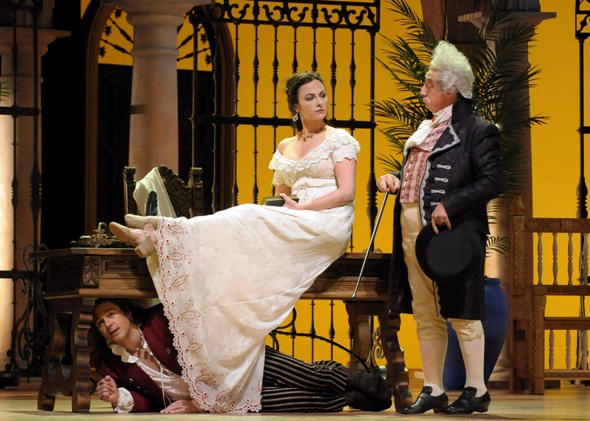
While Figaro (Natha Gunn) hides, Bartolo (Alessandro Corbelli) demands answers from his beautiful ward Rosina (Isabel Leonard) in “The Barber of Seville” at Lyric Opera of Chicago, world premiere Ron Ashford production. (c) Photos by Dan Rest
Review: “The Barber of Seville,” at the Lyric Opera of Chicago, through Feb. 28. ★★★★★
By Nancy Malitz
There is still no opera funnier or feistier than Rossini’s “The Barber of Seville,” at 198 years and counting. When it works, its comedy seems as effortless as a flick of the wrist. Top to bottom, the Lyric Opera of Chicago has accomplished this trick in a sophisticated new production that owes a great deal to the precise funny bones of conductor Michele Mariotti, director Rob Ashford and designer Scott Pask – all in their company debuts.
They have set Lyric’s stage a-twirl for the hilarious antics of a fit and lovable cast led by baritone Nathan Gunn as the confident fixer Figaro. Mezzo-soprano Isabel Leonard, her voluptuous coloratura ablaze, is the fired-up Rosina, lithe and beautiful in her Lyric Opera debut. (She will sing the role at the Metropolitan Opera next season.)
Leggiero tenor Alek Shrader is the Count Almaviva, who pursues Rosina with a stamina that carries him through the elaborate ornamentation of “Cessa di più resistere” (Resistance is futile) at the end of the night. He’s naturally funny, too. If you saw the film “Audition,” the PBS documentary about the 2007 Metropolitan Opera’s national young artist competition, Shrader was the one with the nine high Cs. It’s still a marvelously flexible, if stouter, voice.
The veteran baritone Alessandro Corbelli plays the preening old would-be groom Bartolo, whose comeuppance is sheer delight. Corbelli’s rapid patter is second to none. In truth, it would be hard to imagine a better quartet of comedians, who are all the funnier for playing it straight. Their careers have overlapped elsewhere, of course. (Gunn, Shrader and Leonard are headed to Dallas Opera to do “Barber” in a different production soon.) Leonard and Shrader sizzle in their scenes together. Gunn’s a Figaro in his prime, the ideal factotum, agile and at ease, definitely cocky but likable, and with an aura of good will that’s entirely winning.
The presenter’s challenge, with an opera so worn in the groove as “Barber,” is that everyone knows it already. The situation is known. The jokes are known. The music, famously difficult, is known. It’s a stock show with stock gags and stock expectations, yet there is absolutely no guarantee that any of it will bring a laugh.
How wonderful, then, to hear conductor Mariotti provide fillips of surprise immediately. With the subtle sophistication of a raised eyebrow, the orchestra’s crisp and airy delivery in the overture foreshadowed the careful attention that Mariotti would give throughout. Droll horn and wind solos, whimsically extended trills, transparent textures and a bit of indulgence at the onset of Rossini’s deliciously accelerating crescendos acknowledged the music’s buoyant charm. Rossini’s music is also the simple heart of this very human comedy, and Mariotti got both elements right.
The curtain rose on an ingenious set that reflected the essence of Seville without being heavy-handed about it. There were touches of wrought iron, colonnades and arches, in parts that could be assembled and disassembled like toy building-blocks on wheels. For the first scene change, director Rob Ashford put these structural pieces on the move, in the continuous motion of a slow dance, transforming the scene from outdoors to inside and (with lighting of Howard Harrison) from indigo night to golden day.
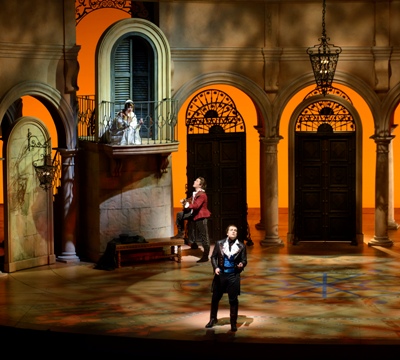
The colonnades, doors and arches in Ron Ashford’s production, designed by Scott Pask, are made up of small units on wheels that can transform before the audience’s eyes. (© Robert Kusel)
It was a fabulous stunt — done in silence, involving simultaneous clockwise and counter-clockwise motions, with a stream of silhouetted servants carrying potted plants and props in one direction, while arches and walls and doors took off in the other. The concept amounted to a sneak peek at backstage machinations normally hidden from view, and the audience was audibly amused.
Ashford began his professional life as a dancer and morphed early into choreography, film and TV, Broadway musicals and legit stage direction. On the one hand, he choreographed Neil Patrick Harris’ opening numbers for the Tonys. On the other, he co-directed an intensely physical “Macbeth” with Kenneth Branagh (coming to the Lincoln Center Music Festival in May). Thank goodness Ashford didn’t let his first opera directing job cut him off from all his other selves.
He enlivened any number of scenes with structured movement that added a contrapuntal thread to the goings on. The men’s chorus, beautifully prepared by Michael Black, has a wonderful role to play in the opening scene, where peasant musicians take preliminary instructions from Almaviva’s servant to be quiet (“Piano, piano”), with the orchestra’s violins in stealth mode. While the Count and his servant dart quickly about the courtyard, trying out various locations from which the Count might “stage” the serenade he wants to sing, the peasants follow like a flock of birds, bunching and swooping as every inch of the stage is explored. The scene ends as Rosina’s window opens a crack and Almaviva dives to strike his pose.
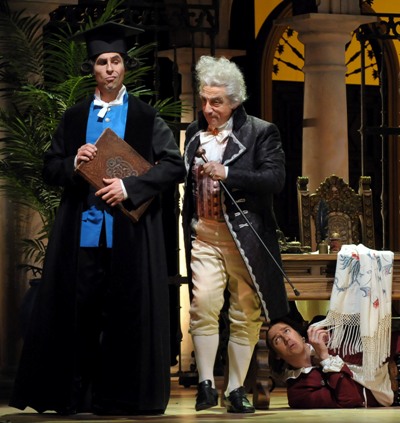
Basilio suggests slandering Almaviva, to cool Rosina’s ardor. Bartolo loves the idea but Figaro is hatching counter-measures.
What fun it must have been to work on this show. All the ensemble scenes were treats to relish, including the Act 1 finale, sung in frozen astonishment (“Freddo ed immobile”) before erupting into confusion as Almaviva’s identity is revealed and the maid Berta (Ryan Center soprano Tracy Cantin) rides the general hysteria to a few high Cs.
Bass-baritone Kyle Ketelson cuts a hilarious swath as the oily music-master Basilio, who suggests slander (“La calunnia”) as the way to take the Count out of competition. And although Ketelson’s wig was as ridiculous as farcical hair can get (costume designer Catherine Zuber’s sly wit was everywhere apparent) his Basilio was actually quite three-dimensional. I loved the way he landed in the middle of one of Figaro’s bizarre schemes and kept trying to put two and two together, finally cottoning on to the idea that it was going to be lucrative to go along, even if he hadn’t the faintest clue why.
In recent years the Lyric Opera of Chicago has imported a number of director-designer teams from the theater side to bring fresh ideas. By now it’s a solid tradition, and although the success rate has been mixed, Ashford’s work shows how valuable it can be to address an old standard from a smart new perspective. This “Barber” fairly dances.
Happily, Ashford will be back at the Lyric to direct “Carousel” in 2015.
Related Link:
- Performance location, date and times: Go to TheatreinChicago.com
- Nathan Gunn sings “Figaro, Figaro, Figaro…”: Catch his interview on Chicago Tonight

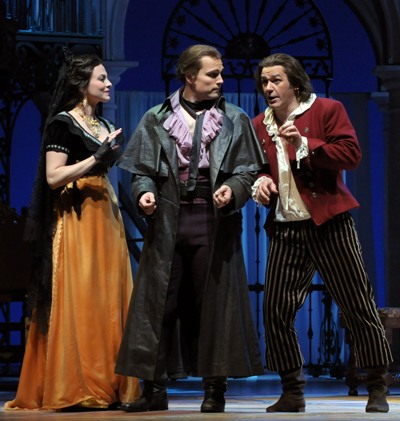

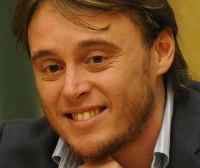

No Comment »
1 Pingbacks »
[…] ★★★★★ The Barber of Seville at Lyric Opera thru Feb. 28 […]